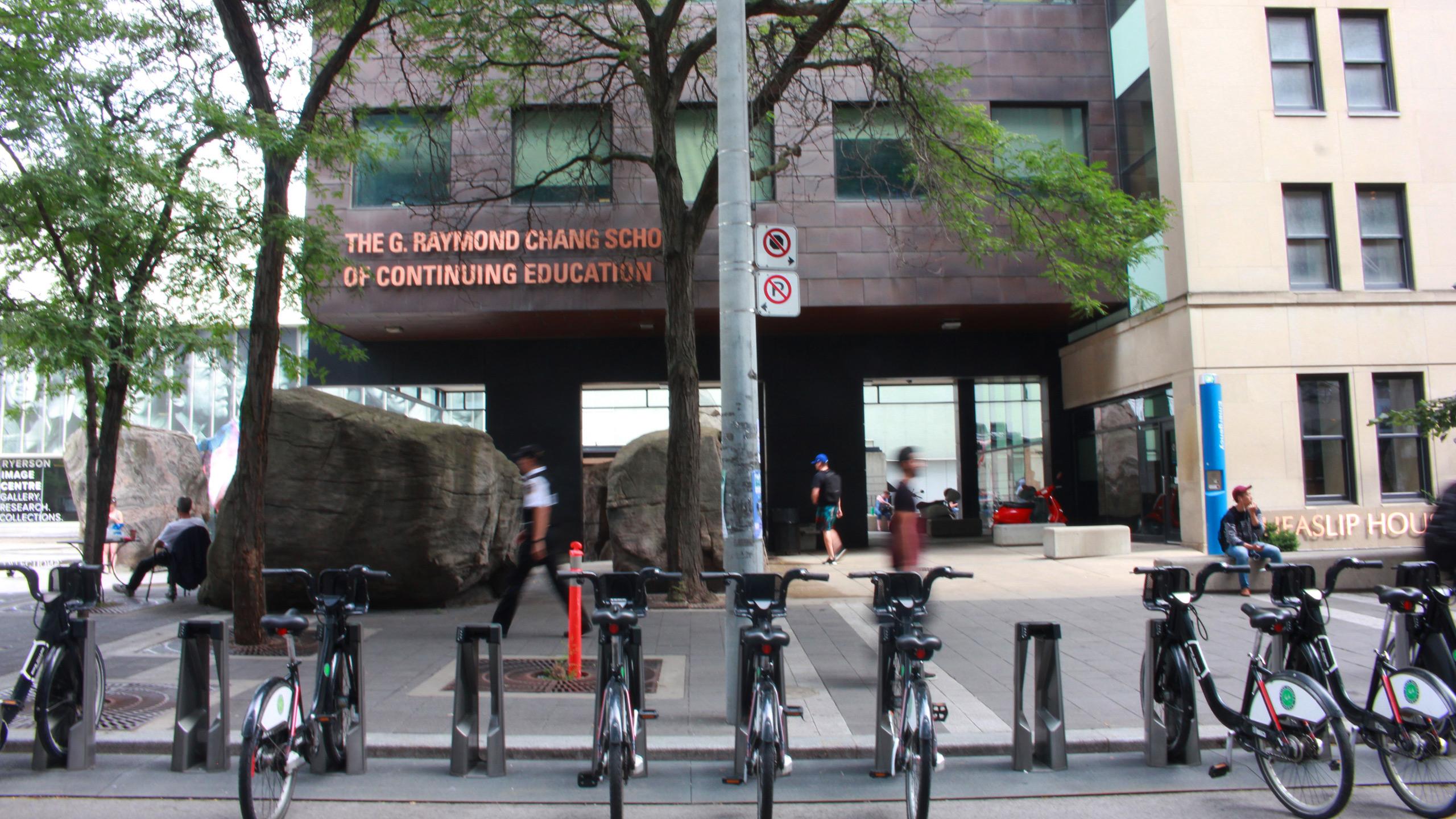By Emma Sandri
Chang School students have one less option when it comes to submitting assignments this year, after used syringes were found in the Victoria Street building’s dropbox over the summer.
The university officially removed the dropbox on Aug. 13, which was located outside on the north side of the Chang School near Lake Devo, after needles were found in the box on two separate occasions one week earlier. Instead of dropping off assignments in the physical box, students have to submit work online via Brightspace by D2L or email, or by physical hard-copy to instructors.
“We found [needles] in Lake Devo in the water area behind the Chang School, we found them near the rocks. We’d have camps of kids here sometimes, even young people take their shoes off. So it’s a bad situation for all,” said Marie Bountrogianni, the dean of the Chang School.
The Chang School is located on 297 Victoria St., a few buildings down from the supervised injection site at The Works. The site allows people with pre-obtained drugs to use them under the supervision of health care workers. The sites have been shown to reduce overdose deaths.
According to a study conducted by the Canadian Paediatric Society in 2008, the risk of infection from needlestick injuries—any wound caused by accidental puncture by a needle—is very low. Specifically, the study notes that there have been no reported transmissions of HIV following injuries caused by discarded needles.
Ryerson administration announced the Sharps Containers Program in February. They installed 18 medical disposal units in high-risk washrooms in Kerr Hall, the Student Learning Centre, Eric Palin Hall and the Victoria Building, among others. “Sharps” can be classified as any object that has the ability to cut the skin such as needles, scalpels, razor blades, scissors and pins, according to the Canadian Centre for Occupational Health and Safety.
The containers were installed to address the needs of students self-managing their own medical conditions, such as diabetes, rather than drug-use related syringes.
“Once a needle is sitting on the ground, those viruses actually die quite quickly,” said Alannah Fricker, founder of the Ryerson chapter for Canadian Students on Sensible Drug Policy (CSSDP).
Fricker said it’s “extremely rare” to get a communicable disease from a needle that’s actually been on the ground or in a garbage for a long period of time.
“It’s challenging because [sharps containers are] extremely important, but there’s also a sort of heightened panic about used needles,” she said. “ I think, and a lot of harm reduction workers think, that the bigger issue is overdosing where people are actually likely to die and sustain physical brain damage.”
In addition to Bountrogianni’s concerns regarding needlestick injuries on campus, she has been vocal about her views on the supervised injection site.
In a tweet published on Aug. 2, before the closing of the dropbox, Bountrogianni asked mayoral candidate Jennifer Keesmaat whether or not she would do anything about the injection site, which she said was “dangerous.”
It is across the street from Timmies next door to our campus. It has attracted drug dealers and other characters. Staff have been assaulted. It is also filthy. https://t.co/0uHspV9jJh
— Marie Bountrogianni, ICD.D (@mbountrogianni) August 2, 2018
Days later, on Aug. 8, Bountrogianni tweeted that the site “attracts drug dealers.”
“It is dangerous and it’s not just dangerous for staff and students—a number of us have been assaulted—but it’s also unsafe for the patients themselves that use the site. The police are there daily, breaking up fights, etc.,” said Bountrogianni.
“No one is against people getting help, I mean I’m a former psychologist, I’m for people getting help. I know that my tweets have been controversial for some, but they’ve also been supported by others.”
Ryerson’s unofficial CSSDP chapter responded to Bountrogianni’s tweets in an open letter posted to Facebook, where they said the real danger is for the patients of the site, many of whom who have been forced into homelessness by high-rent costs, are harassed by passer-by and are targeted by police.
“The nature of her tweets were very stigmatizing and we didn’t feel they were really appropriate coming from an administrator at the school. I was just sort of shocked for a few reasons. I guess it was because students are drug users too,” Fricker told The Eye.
Fricker said she doesn’t think an anti-safe injection site attitude is rational, loving, innovative or inclusive.
“That’s not the message the Dean of the Chang School was giving out. That’s why I felt that we needed to respond because we didn’t feel that was representative of Ryerson,” continued Fricker.
In an emailed response to the the CSSDP, Bountrogianni thanked the group for their “thoughtful” open letter, but reiterated her concern for the lack of resources at the site and the safety of students.
“I get 2-3 people a day telling me they are afraid to come to work, that they’ve been assaulted.” said Bountrogianni in a phone-call with The Eye. “I’ve had three—to my knowledge—patients OD in our first floor washroom.”
Bountrogianni said she has been assaulted on Victoria Street on two separate occasions: One where someone grabbed her chest and another when someone slapped her on the back. She said she chose not to report either incident.
“My immediate thought was what about if it’s a 17-year-old who is away from home for the first time and that’s happening to them?” said Bountrogianni.
The Eye previously reported more outreach staff have been hired by Toronto Public Health (TPH) to service the area in and around the surprised injection site on Victoria Street.
In addition to connecting clients with health and social services and providing harm reduction supplies, these staff members pick up discarded needles.
Ryerson Security said in a statement they haven’t taken extra precautions because of the injection site, but did add “community engagement and crime prevention specialists over the summer.”










Leave a Reply